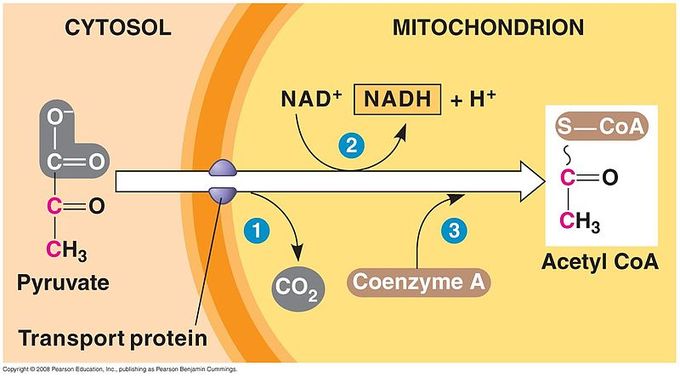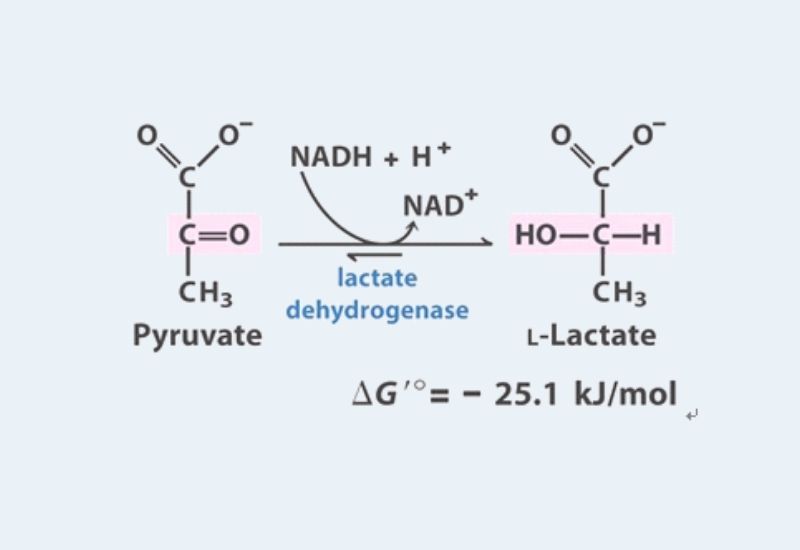Table of Contents
In this article, we will discuss the Fate of Pyruvate or the Utilization of Pyruvate after the formation via glycolysis.
After the formation of Pyruvate through the glycolysis pathway, it may enter into different pathways such as; lactate fermentation in muscles and rbc, alcohol fermentation, and acetyl CoA fermentation (acetyl CoA then enters into TCA cycle to generate energy), or it may enter in biosynthetic pathways such as gluconeogenesis and fatty acid synthesis.
The fate of pyruvate depends on the presence and absence of oxygen;
Fate of Pyruvate in Presence of oxygen
Acetyl CoA formation
- In presence of oxygen, the pyruvate converted into Acetyl CoA with the help of the Pyruvate dehydrogenase enzyme complex, and then it enters into TCA cycle via oxidative decarboxylation.
- Pyruvate dehydrogenase is called enzyme complex because it is made of three enzymes such as E1, E2. and E3. Where E1, pyruvate dehydrogenase; E2, dihydrolipoyl transacetelase; E3, dihydrolipoyl dehydrogenase.
- This enzyme complex requires 5 coenzymes to catalyze the reaction such as TPP, FAD, Lipoate, CoA-SH, NAD+.
- First of all, TPP binds with E1 and releases the Co2 from pyruvate with the transfer of acetyl group to the TPP.
- Now TPP transfers the acetyl group to the Lipoate which is combined with the E2.
- The acetyl groups transfer from the TPP to CoA-SH and forms Acetyl CoA.
- E3 shifts H from reduced lipoate to FAD which gives an electron to NAD+ making NADH + H+.
- After that the Acetyl CoA enters into TCA cycle to generate energy (ATP).

Fate of Pyruvate in Absence of oxygen
Lactate Fermentation
- Under anaerobic conditions or when oxygen concentration decreased in cells the pyruvate converts into lactate with the help of enzyme lactate dehydrogenase. This process is known as Lactic acid fermentation.
- This reaction mainly occurs in muscle, erythrocytes, and some other cells.
- In RBC, they don’t have any mitochondria so their main energy (ATP) source is Glycolysis. When the NAD+ concentration becomes low they perform Lactic acid fermentation to generate NAD+, then they use it in glycolysis pathway to yield ATP.
- During exercise or vigorous muscle contraction, the oxygen level in muscles is decreased as a result of the lactic acid is formed within the muscles. It causes muscle cramps and pain. This is how the brain is responding to the body to STOP!!! When oxygen level becomes normal in the muscle the pyruvate is again converted into acetyl CoA which may enter into the TCA cycle to produce ATP.

Alcohol Fermentation
- Alcohol Fermentation is a two-step process. In the first step, the pyruvate converted into Acetaldehyde, and then in the second step, it converted into Ethanol with regeneration of NAD+ and formation of carbon dioxide.
- The enzyme pyruvate decarboxylase catalyzes the first step with the release of one molecule of carbon in the form of Co2 and in presence of TPP and Mg++.
- The enzyme Alchohol dehydrogenase catalyzes the 2nd step of the reaction with the transfer of one proton molecule from NADH.
- Pyruvate decarboxylase enzyme needs Thiamine Pyro Phosphate (TPP) and Mg2+ as coenzyme and a cofactor individually. Thiamine (vitamin B1) carries a thiazolium ring and functions as a source of TPP.

Biosynthetic Pathway
- Pyruvate can further infiltrate into the biosynthetic pathways for example fatty acids biosynthesis and gluconeogenesis.
- Pyruvate converted into acetyl CoA by the activity of pyruvate dehydrogenase complex this acetyl CoA further enters into the biosynthetic pathway alongside TCA.
- Pyruvate can further infiltrate into gluconeogenesis by the activity of pyruvate carboxykinase transforming it into oxaloacetate which with several steps reaction transforms into glucose. When the glucose level of cells decreased they activate the gluconeogenesis pathway to generate glucose from Pyruvate.
